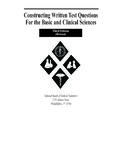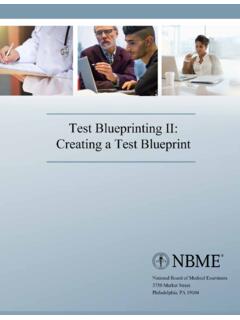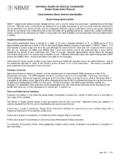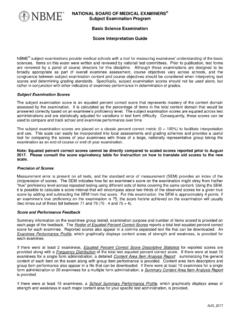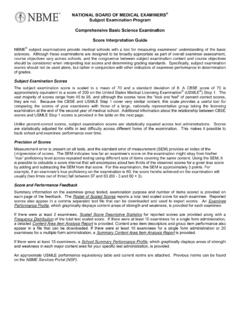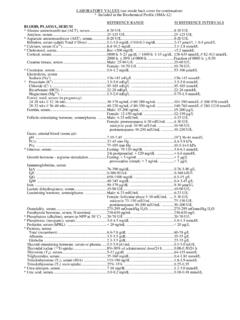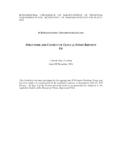Transcription of NATIONAL BOARD OF MEDICAL EXAMINERS …
1 NATIONAL BOARD OF MEDICAL EXAMINERS Subject Examination Program Clinical Science Examination Score Interpretation Guide New Score Scale Information (Effective August 2015) GRPID:CLNEURO$$ NBME subject examinations provide MEDICAL schools with a tool for measuring examinees' understanding of the clinical sciences. Items on this examination were written and reviewed by NATIONAL test committees. Prior to publication, test forms are reviewed by a panel of course directors from this discipline.
2 Although these examinations are designed to be broadly appropriate as part of overall examinee assessment, course objectives vary across schools, and the congruence between subject examination content and course objectives should be considered when interpreting test scores and determining grading standards. Specifically, subject examination scores should not be used alone, but rather in conjunction with other indicators of examinee performance in determination of grades.
3 Subject Examination Scores The subject examination score is an equated percent correct score that represents mastery of the content domain assessed by the examination. It is calculated as the percentage of items in the total content domain that would be answered correctly based on an examinee s proficiency level. The subject examination scores are equated across test administrations and are statistically adjusted for variations in test form difficulty. Consequently, these scores can be used to compare and track school and examinee performance over time.
4 The subject examination scores are placed on a classic percent correct metric (0 100%) to facilitate interpretation and use. This scale can easily be incorporated into local assessments and grading schemes and provides a useful tool for comparing the scores of your examinees with those of a large, nationally representative group taking the examination as an end- of-course or end-of-clerkship examination. Note: Equated percent correct scores cannot be directly compared to scaled scores reported prior to August 2015.
5 Please consult the score equivalency table for instruction on how to translate old scores to the new scale. Precision of Scores Measurement error is present on all tests, and the standard error of measurement (SEM) provides an index of the (im)precision of scores. The SEM indicates how far an examinee s score on the examination might stray from his/her true proficiency level across repeated testing using different sets of items covering the same content. Using the SEM, it is possible to calculate a score interval that will encompass about two thirds of the observed scores for a given true score by adding and subtracting the SEM from that score.
6 For this examination, the SEM is approximately 4 points. If an examinee s true proficiency on the examination is 75, the score he/she achieved on the examination will usually (two times out of three) fall between 71 and 79 ( 75 - 4 and 75 + 4). Score and Performance Feedback Summary information on the examinee group tested, examination purpose and number of items scored is provided on each page of the feedback. The Roster of Equated Percent Correct Scores reports a total test equated percent correct score for each examinee.
7 Reported scores also appear in a comma separated text file that can be downloaded. An Examinee Performance Profile, which graphically displays content areas of strength and weakness, is provided for each examinee. If there were at least 2 examinees, Equated Percent Correct Score Descriptive Statistics for reported scores are provided along with a Frequency Distribution of the total test equated percent correct score. If there were at least 10 examinees for a single form administration, a detailed Content Area Item Analysis Report summarizing the general content of each item on the exam along with group item performance is provided.
8 Content area item descriptors and group item performance also appear in a file that can be downloaded. If there were at least 10 examinees for a single form administration or 20 examinees for a multiple form administration, a Summary Content Area Item Analysis Report is provided. If examinees were tested at your school in the previous academic year, a Year-End Report is provided. The report summarizes the performance of first-time takers and is posted annually in November to the NBME Services Portal (NSP).
9 NATIONAL BOARD OF MEDICAL EXAMINERS Subject Examination Program Clinical Science Examination Score Interpretation Guide New Score Scale Information (Effective August 2015) GRPID:CLNEURO$$ Grading Guidelines Grading guidelines for this exam have been developed by a nationally representative group of clerkship directors to assist schools and institutions in setting fair and valid passing and honors standards for students taking this exam. An abbreviated summary of the grading guidelines is provided and the full study with a list of participating schools is reported on NSP.
10 Norms Total academic year and quarterly norms are provided to aid in the interpretation of examinee performance. The norms reflect the performance of first-time taker examinees who took a paper and/or web form as an end-of-course or end-of-clerkship examination across an entire academic year and by quarterly testing periods. Quarterly norms have been provided because scores in some subject examinations are progressively higher for examinees of equivalent ability who take the relevant clerkship later in the academic year.
